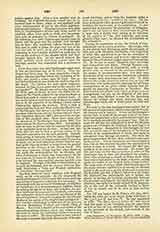

Lenormant, CHARLES, French archaeologist, b. in Paris, June 1, 1802; d. at Athens, November 24, 1859. After pursuing his studies at the Lycee Charlemagne and the Lycee Napoleon, he took up law, but a visit to Italy and Sicily (1822-23) made him an enthusiastic archaeologist. In 1825 he was named sub-inspector of fine arts and a few months later married Amelia Syvoct, niece and adopted daughter of the celebrated Mme Recamier. He visited Italy, Belgium, Holland, and accompanied Champollion to Egypt, where he devoted himself to the study of architectural works. Later he travelled through Greece as assistant director of the archaeological department of the Morea scientific commission. On his return he was appointed curator of the works of art in the royal palaces (1829). In 1835 he was Guizot’s substitute at the Sorbonne. Although the chair was that of modern history, he lectured chiefly on ancient history, more especially on the origins of Greek civilization. In 1836 he was appointed curator of printed books in the Royal Library, and in 1839 was elected member of the Academy. In 1840 he was made curator of the Cabinet of Medals. Guizot, who became minister of foreign affairs in 1841, sent him on a mission to Greece. On returning from this second visit to the East he continued his lectures at the Sorbonne, and made a particular study of Christian civilization in its sources. This study made of him a true Christian, and from that time his lectures bore the impress of his deep Catholic belief. He gave voice to his convictions in his “Questions historiques” (Paris, 1845), in his work on the “Associations religieuses dans la societe chretienne” (Paris, 1866), and in many serious articles in the “Correspondant”. His writings greatly influenced the much discussed question of freedom of teaching (liberte d’enseignement). In 1846, the students, in retaliation for the suppression of M. Quinet’s chair, compelled Lenormant to give up his professorship; he was then given the editorship of the “Correspondant” which he resigned in 1855. In 1848 he was named director of the commission of historical monuments, and in 1849 an almost unanimous vote of the members of the Academy appointed him to the chair of archaeology in the College de France. From that time he devoted himself entirely to the teaching of Egyptian archaeology. He died while on an expedition undertaken for the sake of initiating his son into the knowledge of the monuments of antiquity.
Many articles from the pen of Lenormant appeared in the “Annales de l’Institut Archeologique de Rome“, the “Memoires de l’Academie des Inscriptions”, the “Revue de Numismatique”, and the “Correspondant”. His chief independently published works are: “Les Artistes contemporains” (Paris, 1833, 2 vols.); “Introduction a l’histoire de l’Asie occidentale” (Paris, 1838); “Musee des Antiquites egyptiennes” (Paris, 1842); “Questions historiques” (Paris, 1845), besides two valuable collections, “Tresor de numismatique et de glyptique” (Paris, 1834-50) (in collaboration with Paul Delaroche and Henriquel Dupont) and “Elite des monuments ceramographiques” (1844-58) (with De Witte).
F. MAYENCE

